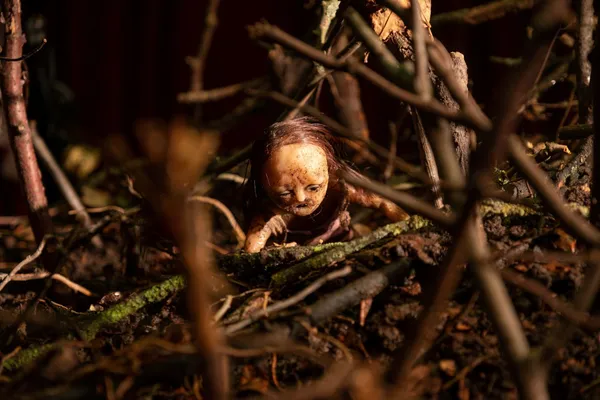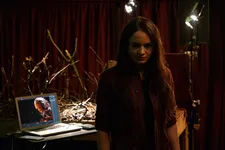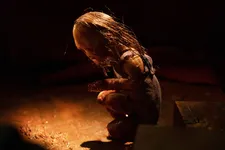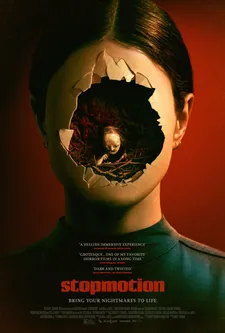 |
| Stopmotion |
Director Robert Morgan’s Stopmotion follows Ella (Aisling Franciosi), a young stop motion animator grieving the loss of her mother. Renting a flat where she begins work on a new macabre puppet film, she struggles to escape the shadow of her mother’s formidable and celebrated reputation. Worse, she finds her mind begins to fracture when the creations from her imagination begin to take on a life of their own, threatening to destroy her.
In conversation with Eye For Film, Morgan discussed the mysterious origins of ideas, how the uncanny seduced his youthful imagination, and the drive to make a film that divides audiences and sticks in their minds.
Paul Risker: What was the seed of the idea for Stopmotion, and what compelled you to want to tell this story at this point in time?
Robert Morgan: I have a background in stop motion animation and I’ve been making animation short films for 20 years. I thought the original idea of a lead character, a stop motion animator who is making a film would be interesting because I'd never seen that depicted before as a vocation.
I married that with the second idea, which was an experience I had when I was making the short film, Bobby Yeah. I was improvising and I had the sensation as I was working that it was taking on a life of its own. It was no longer a case that I was dictating what I wanted it to be.
When you work on something, whether you're a painter or a writer, the thing takes on a life of its own. It starts talking back to you, telling you what it wants to be. So, I had the strong sensation that the film didn't give a shit what I wanted, it wanted to be something else, and I had to follow it. I thought that's kind of weird and had the idea of a creative object being alive in some way.
 |
| Stopmotion |
PR: Fear comes from inside our mind, yet horror films often play on what’s external. One source of terror is obsession, and Stopmotion is a story about how it can both motivate and tear us down.
RM: I prefer it when horror is interior because you can't escape from it. You can't defeat it and you can’t kill it with a flamethrower, especially if it's a part of you that you've an ambivalent relationship with. This is what happens in Stopmotion – she desires and is terrified of it at the same time.
Whenever obsession is involved, it's a double-edged sword. You're obsessed with it because you love it, but at the same time it can drive you to places where it stops being healthy. But you can't stop because you have this obsession. It's simultaneously something you want but it's destroying you.
It's the question of where ideas come from. Sometimes you have an idea, and you don’t know where it came from – it’s a mysterious thing. David Lynch talks about how he believes ideas are actually out there somewhere and they enter your head.
There's a lack of ownership of these things, and it sometimes seems a bit alien to Ella – she doesn't know where it comes from. ‘Why am I thinking this? Why am I obsessed with it? Is it me coming up with it or is it someone else?’ The film deals with that ambiguity as well.
PR: By trying to escape her mother's shadow, Ella plunges herself into another. She’s a doomed and tragic character.
RM: I'm a big fan of the feeling of dread in horror films. People often talk about how you need to make your film surprising. Where’s the twist? You need to turn it on its head. We fought against that with Stopmotion because to me the power of it is in its inevitability.
There's no great surprise about where this goes, and I don't mind that. Part of its ride is you're watching this slide and like a nightmare you can't get out of it. You’re watching the character do something where you're thinking that on the one hand, she's doing the worst possible thing, and yet hopefully, through Aisling's performance, you understand why she's doing it. So, there's an inevitability, and it’s an inexorable slide towards wherever it goes.
 |
| Stopmotion |
PR: I recall a creative writing teacher talking about the value of telling a familiar story well. Often, we spiral down the rabbit hole of being original or making a game-changer.
RM: I was very conscious that I was taking a fallen artist, or an artist goes mad story. That's as much an archetype as a mad scientist or a corrupt cop. It has been done many times, but you haven't seen it done as a stopmotion animator with all the paraphernalia that comes along with that. So, for me I'm very comfortable with the fact that it's an archetypal story told in a different way.
The word ‘cliché’ gets used to criticise some horror films, but you could also use the word ‘archetype.’ To me, they're different ways of looking at it.
PR: What reason would you give to explain why stop motion and puppets are so oppressively creepy?
RM: Puppets are inherently uncanny because they have the familiarity of looking like us, but they also have a fakeness. They have an attraction and repulsion at the same time. The stop motion medium itself has that same uncanniness because it's moving in a slightly weird way. It looks alive, but it feels dead.
The strange jerkiness is what drew me to it when I was a kid because it just felt wrong, it felt unnatural.
I'm often surprised that more people don't use stop motion animation to explore the uncanny or horror because it's a natural fit. Then if you start introducing textures that are more visceral, things that resemble life, but life gone a little bit wrong, it adds a whole other layer.
PR: The flat that Ella rents changes during the film, becoming a more hellish space. The slow grind of the stop motion project begins to mirror the eternal grind of being stuck in hell.
RM: It's partly to do with the sound. I had an amazing sound designer on this film, Ben Baird, who had a lot of amazing concepts, some of which you don't spot on the first viewing. There are very clever and subtle things going on in there. One of the things he did which was not in the original plan, and I agreed with him when I saw the tests, was he started to remove the sound from that space. It became very quiet, and the silence started to become almost a presence as the film goes on. It’s almost an imperceptible thing that’s happening in the background.
 |
| Stopmotion poster |
PR: With stop motion you can feel its physicality and the film’s sound design provokes the feeling of discomfort and dread. Too many films are polished now and lack a rough or raw feel.
RM: … I like films that stick in your throat. I don't get why you would want to make the type of film that you’d go out on a Friday night to watch, and you've forgotten about it by the time you get home. All that effort… don't you want to make something that's maybe going to alienate some people? Maybe some will not like it, but the people that do like it, those are the people I'm making it for.
I want to be challenged and fucked up. I want it to sit in my brain and not leave. The rawness, the crudity and the imperfection are part of what stop motion is. I've read some comments about the trailer that say, “I bet they used CGI for this.” Why would you make a film about stop motion and then use CGI? Of course it's stop motion, that's the whole point of the film.
PR: It’s important to put your expectations aside and be open minded enough to embrace the film the filmmaker is trying to make.
RM: I've been guilty of that myself where I've gone to see a film and I thought I was going to get something that I didn't get. I was pissed off and therefore it's a crap film. Then years later you watch it again without expectations and you think, ‘What was I talking about? It’s amazing.’ You accept it for what it is instead of what it's not, and I wonder sometimes if people have lost the ability to watch films with an open mind.
Stopmotion is in US theatres on Friday 23rd February and On Demand from Friday 15 March.





















